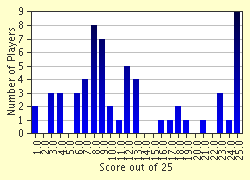Quiz Answer Key and Fun Facts
1. From whom has Gaveston received a letter that he reads aloud at the beginning of the play?
2. Which sorts of men does Gaveston plan to use to make the "pliant" king do anything that he (Gaveston) wants?
3. What relation are the Younger Mortimer and the Elder Mortimer to each other?
4. What pet-name for the King does Gaveston use in his aside to the audience?
5. Who is the only noble to speak out on the King's side in this first confrontation at the beginning of the play?
6. Lancaster leaves the court in defiance telling Edward he must either change his mind or expect to see something floating in blood. What is it that will "float in blood"?
7. Which clergyman do Gaveston and the King throw into the gutter?
8. Amongst the titles that Edward II showers on Gaveston are Lord High Chamberlain, Chief Secretary to the State, King and Lord of Man. Which important earldom does he also give to Gaveston?
9. With which of the nobles does the Queen seem to find the most sympathy?
10. How does Edward try to influence the nobles into a position where they won't support the Archbishop of Canterbury in his petition to have Gaveston exiled again?
11. Which power base does he threaten to destroy after the nobles have left and he has signed the paper banishing Gaveston?
12. What does Edward call Isabella just before he says farewell to Gaveston?
13. What is the main argument that Mortimer puts to the other nobles to suggest that Gaveston should be brought back from banishment?
14. What advice does the Elder Mortimer give to the Younger Mortimer before he departs to fight in Scotland?
15. From whom does the King's niece receive a love letter?
16. Where does Gaveston land on his second return from exile?
17. The symbolic device that Mortimer describes to the King as they wait for Gaveston to land is of a cedar tree with eagles on the top branches. What symbolises Gaveston in the rest of this device?
18. Which of the nobles attacks and wounds Gaveston when he offers each of them insults on his return to England?
19. What complaint do Lancaster and Mortimer make against Edward when they decide to "speak their minds"?
20. When Kent decides to throw in his lot with the rebels who is the nobleman who immediately decides to trust him?
21. After they have captured Gaveston which two men amongst the nobles want to give Edward one last chance of seeing his favourite?
22. Which of the rebels is in the end directly responsible for Gaveston's death?
23. To which foreign nobleman does Isabella turn when her brother, the King of France, refuses to help her?
24. After the Earl of Leicester and Sir Thomas Berkeley Edward II is placed with his final set of gaolers. What are their names?
25. In the play "Edward II" how does Marlowe arrange the King's death on stage?
Source: Author
Philian
This quiz was reviewed by FunTrivia editor
Bruyere before going online.
Any errors found in FunTrivia content are routinely corrected through our feedback system.

